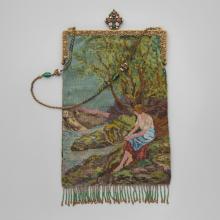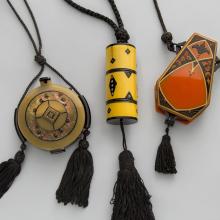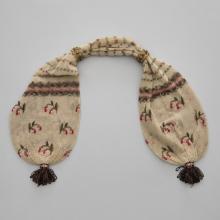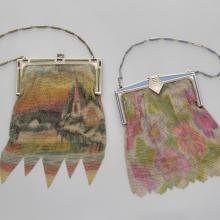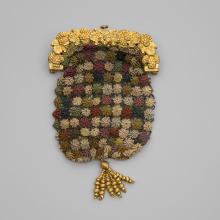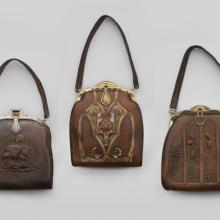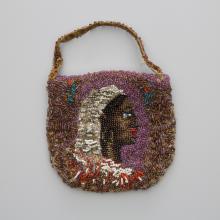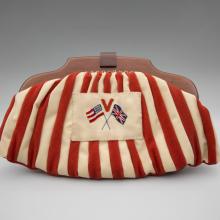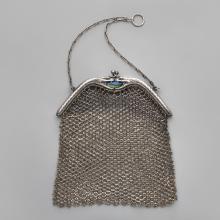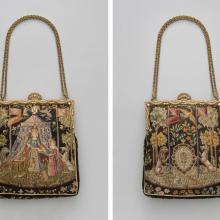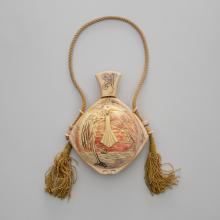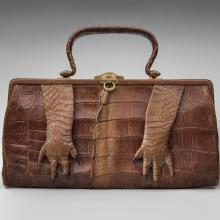International Terminal
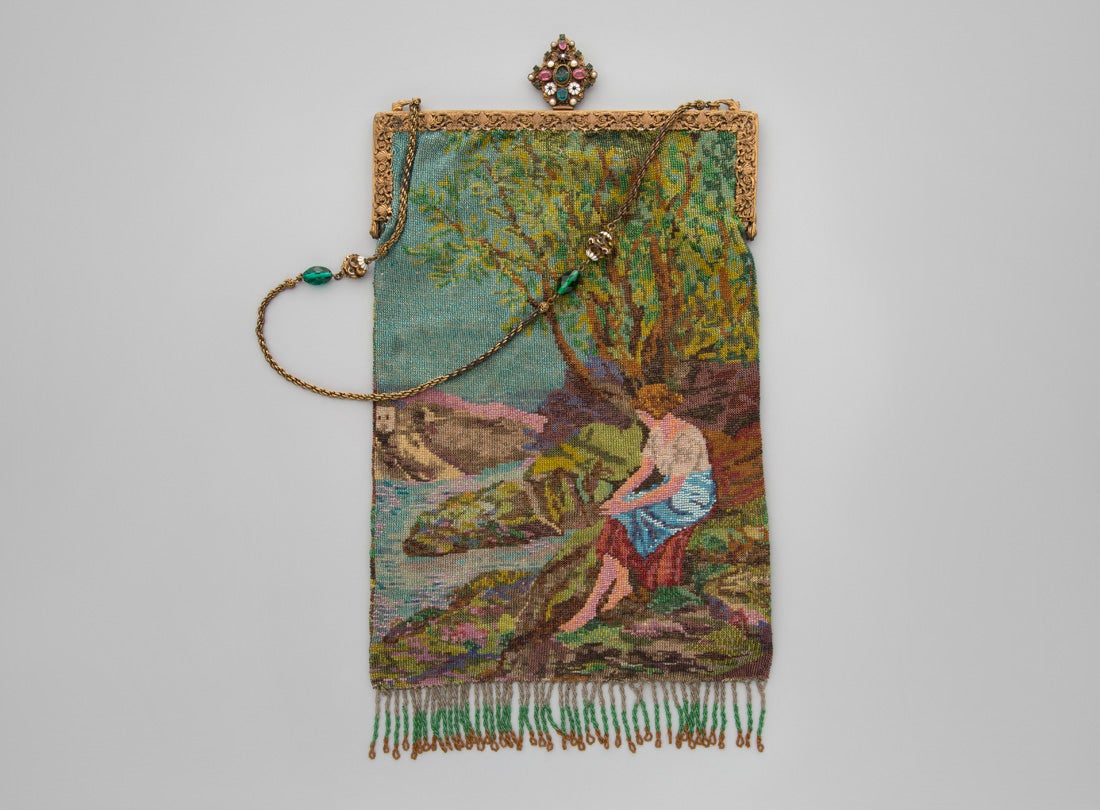


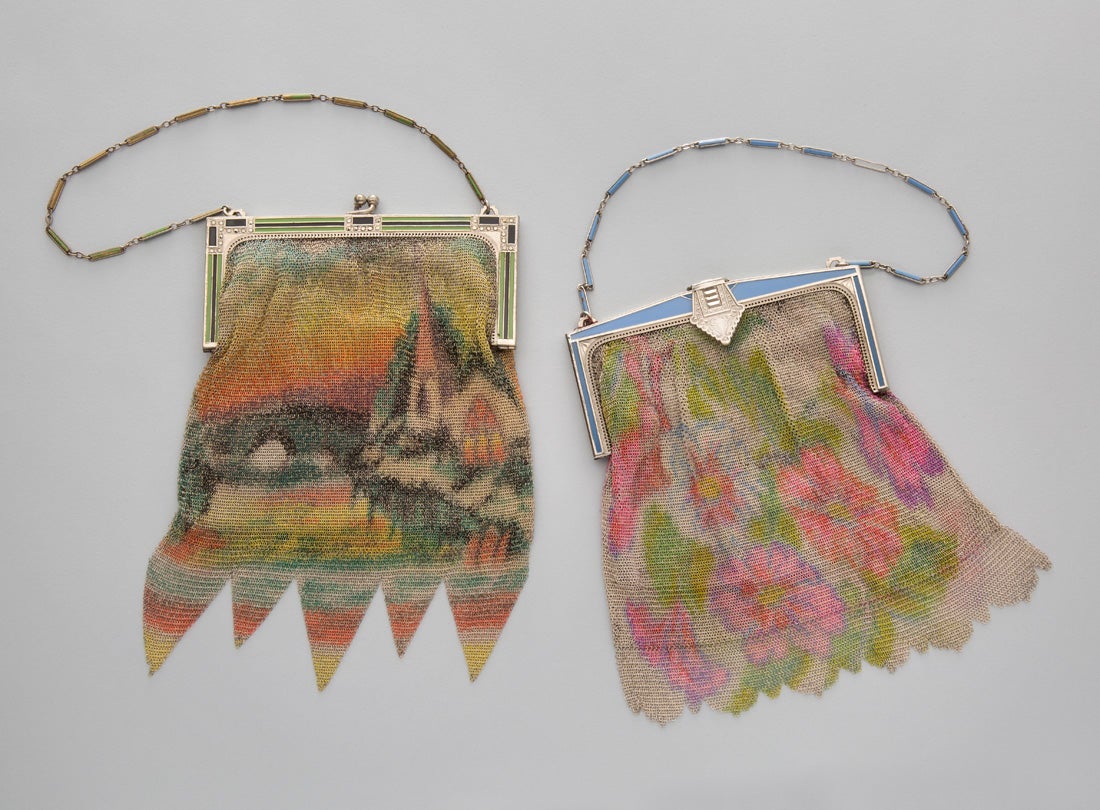

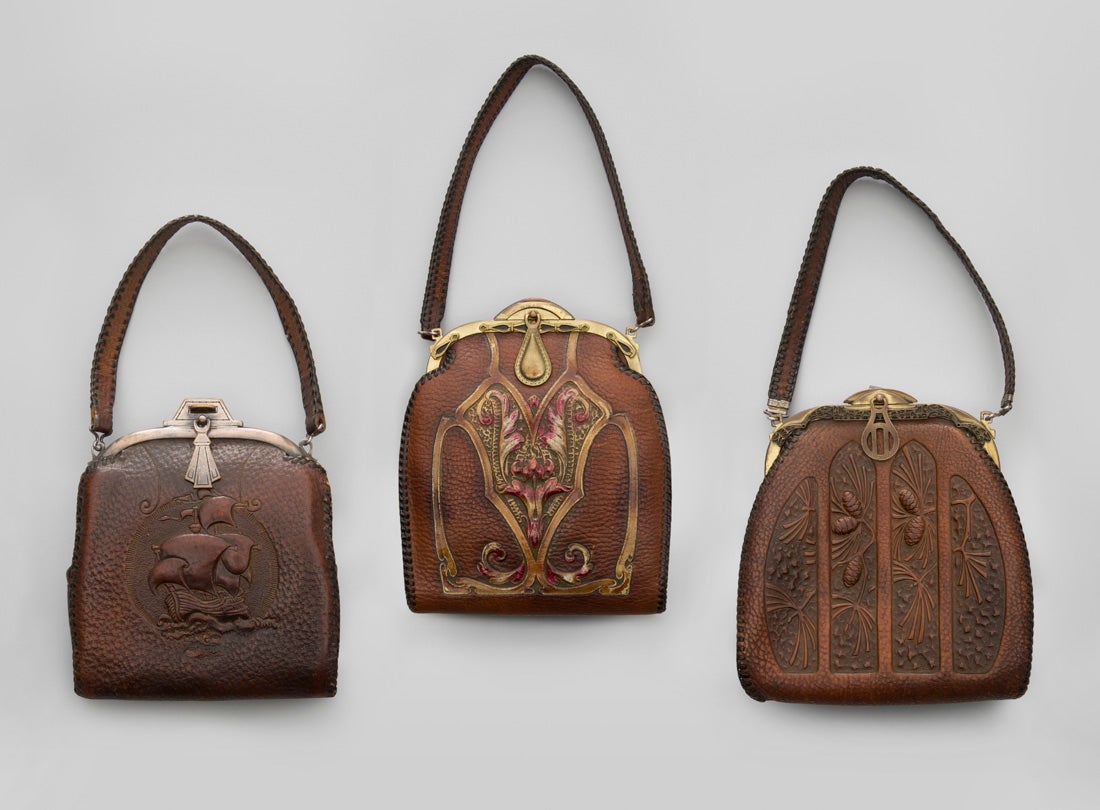
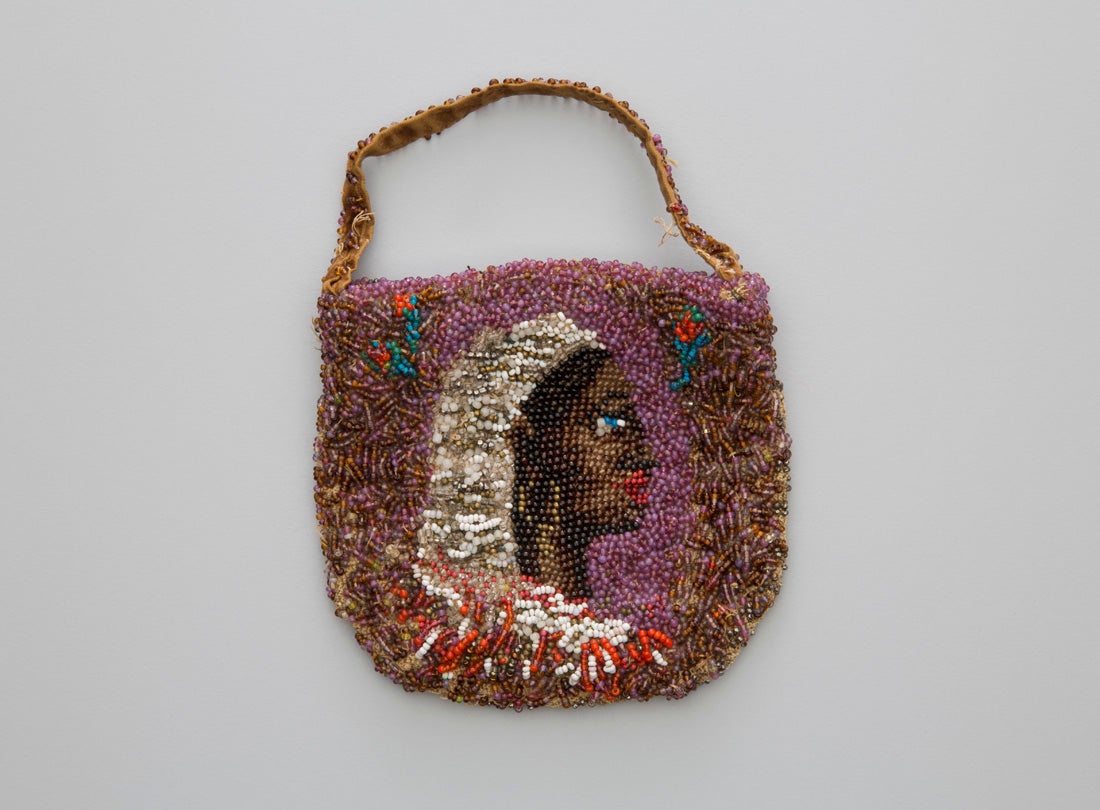


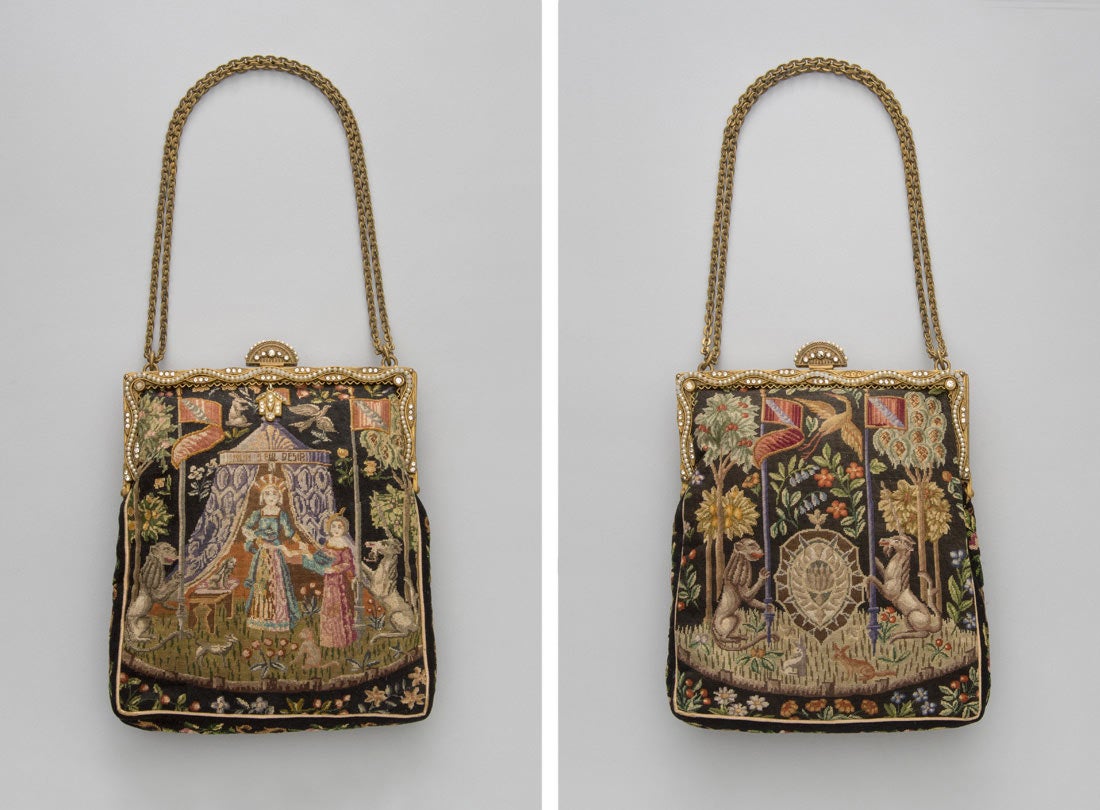
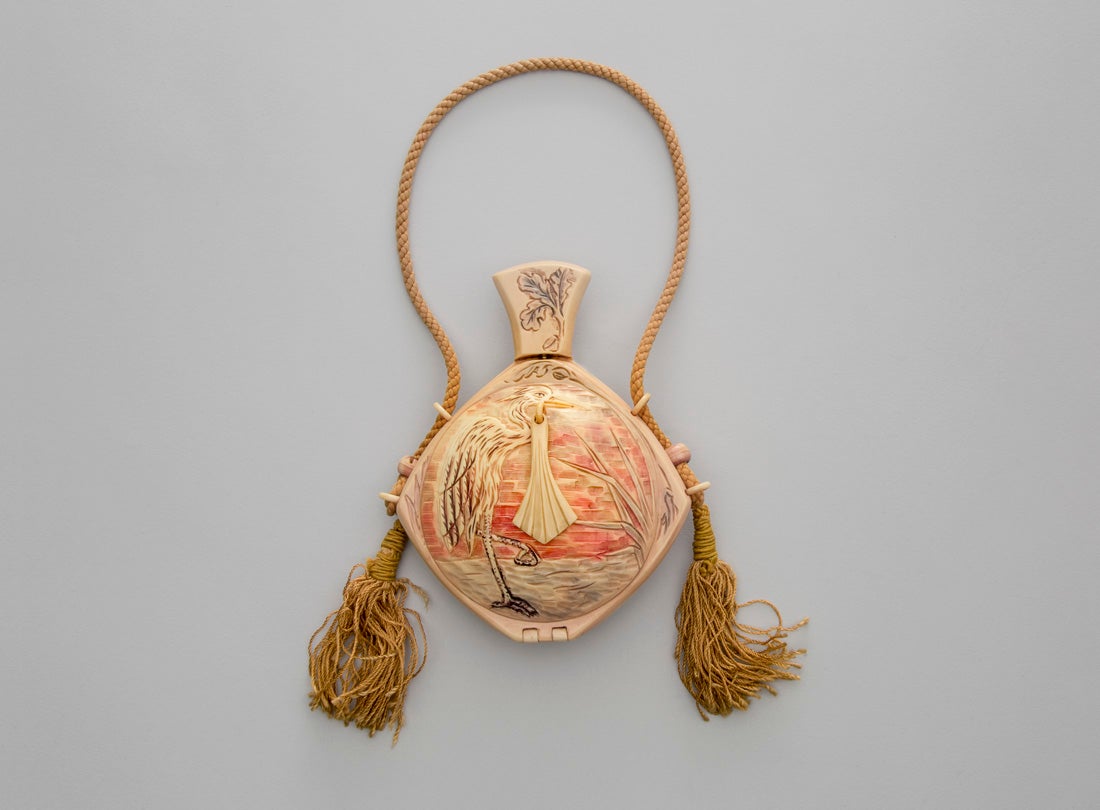
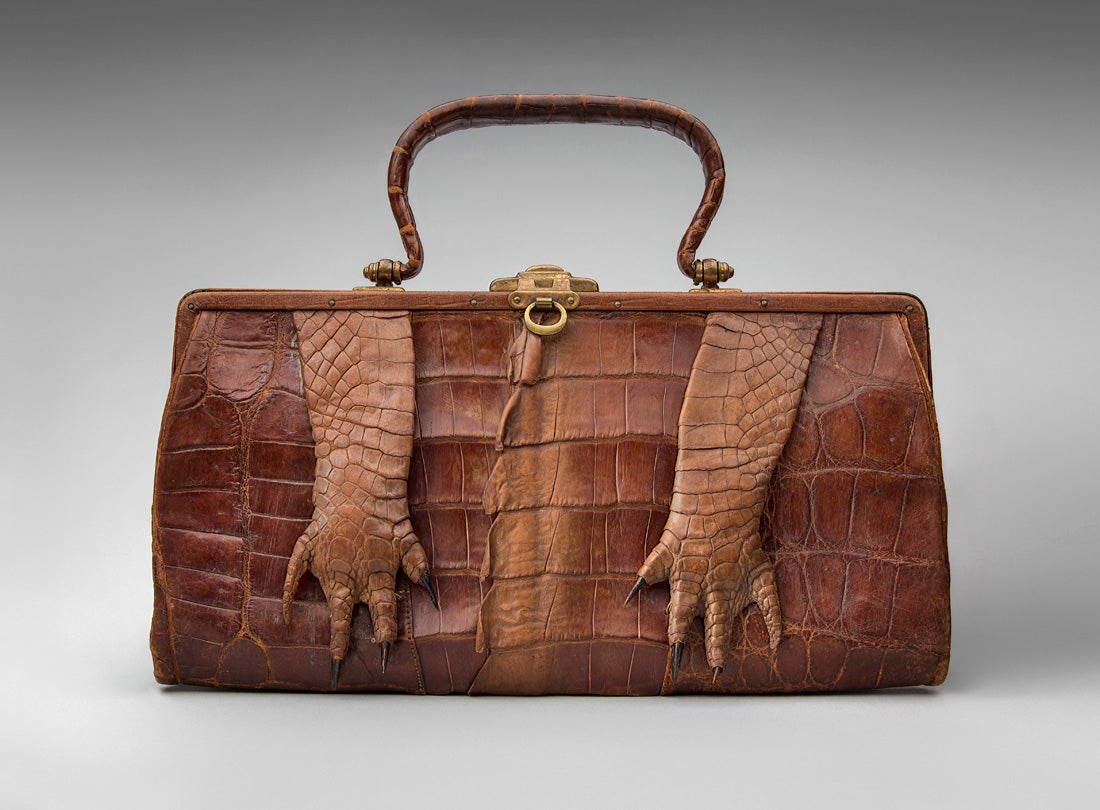
Scenic beaded purse c. 1914
Europe
glass beads, metal, fabric, silk
From the Collection of Melissa Overdorf
L2015.2306.004
Knitted, beaded bags required thousands of beads and could take weeks to complete. Beads first had to be strung according to the pattern before knitting could begin. Because an extraordinary amount of time and effort went into making knitted, beaded handbags, they garnered extremely high prices. Transparent, opaque, and iridescent beads in round and bugle or elongated shapes were all employed. Numerous beaded bags were imported from Europe, especially Germany.
This exceptional knitted, beaded scenic bag required the utmost skill to complete. It was inspired by the image Die Forelle created by Austrian painter Karl Zewy (1855–1929).
Dance purses c. 1920s–30s
France
celluloid, rhinestones, silk cord
From the Collections of Paula Novell Higgins and Mary Nunn
L2015.2304.019; .020, L2015.2308.026
During the mid-1920s to ‘30s, women’s fashions changed dramatically. Inspired by film stars, women now wore eye makeup and lipstick, cut their hair in short bobs, and smoked openly in public for the first time. The handbags of this era reflect these changing times. Purses tended to be more glamorous than practical. In the evenings, women wore sleeveless dresses with low cut backs and sported ultra compact purses, which allowed them to carry just a few essentials. Easy to dance with, these lightweight, tiny bags dangled from the wrist, complementing a woman’s attire. Vanity purses had built-in mirrors with powder or rouge compacts and a full tassel fringe that cleverly concealed a lipstick compartment. Lipstick containers also dangled from the top of purses. Some contained inset watches, lighters, scent bottles, and compartments for cigarettes. They came in a variety of shapes, from figurative to triangular, round, and square. Many of these bags were made in France from newly introduced plastics, such as celluloid and Bakelite, and were lined with rayon, the first synthetic fabric.
Netted miser’s purse late 1700s
Britain
silk, metal
Courtesy of Paula Novell Higgins
L2015.2308.008
Miser’s purses, which became commonplace by the late eighteenth century, differed from other types of purses in that they were primarily used to hold coins and currency. Miser’s purses were netted, knitted, and later crocheted in a shape similar to a stocking. Decoration included simple beadwork, embroidery, tassels, or fringe. These purses have a slit through the middle for insertion of coins. Two metal rings slide down to the ends, preventing coins from moving past the ring or being lost. Both men and women used them throughout the nineteenth century and into the early twentieth century.
Dresden mesh bags c. 1924–30
Whiting & Davis
Massachusetts
enamel on metal mesh
From the Collections of Mary Nunn and Kathy Gunderson
L2015.2309.033, L2015.2304.007
Wade Davis, later to become Whiting & Davis, a silversmith company outside of Boston, first offered handmade ring mesh purses in the United States in 1892. In 1912, Charles Whiting worked with inventor A. C. Pratt to create the first automatic machines for making and joining mesh. Each machine could produce hundreds of thousands of links per day in comparison to about one thousand links previously created by hand in a slow, laborious process. Whiting & Davis enjoyed great success, particularly in the 1920s and ‘30s. Mesh came in two styles: fine ring and flat armor mesh. Around 1924, Whiting & Davis began applying colorful enameled patterns onto armor mesh bags—from bold Art Deco designs to delicate floral patterns. Around the same period, they began silk-screening colors onto ring mesh bags, which they referred to as Dresden mesh. This gave the bags an impressionistic watercolor appearance. Flappers, movie stars, and fashionable women everywhere sported mesh handbags.
Spiderweb design needlework purse c. 1820
possibly France
silk, metal
Courtesy of Paula Novell Higgins
L2015.2308.009
A multitude of finely embroidered purses in pocketbook or envelope-shaped and drawstring styles were made in the eighteenth century. Traveling merchants peddled purses; milliners, fancy goods stores, haberdashers, and perfumers also sold them. During the nineteenth century, purses were knitted, embroidered, and later crocheted. Entirely beaded bags displayed a variety of scenes from pastoral settings to historic places. Bags in the nineteenth century continued to employ drawstring handles, though numerous examples displayed elaborate metal frames, which were often passed down from one generation to the next. Makers also created purses from metal, leather, tortoiseshell, and ivory during this century.
Arts and Crafts-style handbags c. 1920s
United States
leather, metal, thread
From the Collections of Jennifer Whitehair and Mary Nunn
L2015.2301.065, .068, .2304.026
Hand-tooled and embossed leather bags became popular around 1900 and continued to be fashionable until the late 1930s. Taking inspiration from Arts and Crafts, Art Deco, and Art Nouveau designs, these bags were made of genuine English and Spanish steerhide, cowhide, and calf leather. They were made in hundreds of styles. Skilled artisans typically made these bags in cottage industry settings. For instance, Elbert Hubbard, a top producer of hand-tooled leather handbags, founded the Roycroft Shops in East Aurora, New York. His workshop followed the ideas of William Morris, leader of the late nineteenth-century Arts and Crafts movement. Many companies offered these bags as their popularity escalated. A less costly alternative to hand-tooled bags, some companies made genuine leather bags with embossed designs, which produced a similar effect. Separate manufacturers commonly made the frames for these purses in gunmetal, copper, hammered brass, and occasionally plastic.
Beaded bag depicting an African-American woman c. 1840–60
United States
glass beads, fabric
Courtesy of Paula Novell Higgins
L2015.2308.016
For centuries, girls began to learn sewing and other fancywork at a young age. For many, sewing remained a necessity even after the Industrial Revolution. Women who could not afford to purchase handbags created their own fanciful creations out of what they had on hand—even something as simple as cigar bands or part of a crazy quilt could be creatively transformed into a bag. Others decorated purses with imagery that reflected their local surroundings. Some incorporated portraiture onto bags, which might be rendered in paint on fabric or beads. For instance, an enslaved African-American most likely created the self-portrait depicted on this small beaded bag.
Further encouraging women, numerous instruction booklets and intricate patterns for knitting and crocheting bags and purses could be found in magazines, books, newspapers, and booklets devoted entirely to the subject, particularly in the late 1800s and early 1900s. Among the items most prized were beaded bags.
Victory purse c. 1939–45
United States
fabric, wood
From the Collection of Jennifer Whitehair
L2015.2301.047
During World War II (1939–45), approximately 300,000 women served in new female branches of the military both at home and abroad. The two principal non-combatant military service roles for women included the Women’s Army Corps (WAC) and the Women Accepted for Voluntary Emergency Service (WAVES). Women also served in the Army Nurse Corps, the Navy Nurse Corps, U.S. Marine Corps Women’s Reserve (USMCWR), the U.S. Coast Guard Women’s Reserve (SPARS), and as Women Airforce Service Pilots (WASP). Others served as volunteers for the American Red Cross. Although the war brought swift and dramatic changes to women’s fashion, even service uniforms required a purse.
Some purses were made with military logos in support of the war effort, such as the “V.” for Victory. Other purses were made as a sign of friendship between two countries. Women also cleverly converted military garb, including simple garrison caps into handheld clutches. Purses might hold treasured letters and telegrams exchanged by loved ones during long periods apart throughout World War II.
Mesh chatelaine bag with snakes c. 1900
Europe
sterling silver, enamel
From the Collection of Jennifer Whitehair
L2015.2301.007
Before the bodies of metal mesh purses began to be colorfully enameled in the mid-1920s, their frames were elaborately engraved or embossed, many in the Art Nouveau style. Silver ring and armor mesh bags were favored from the late nineteenth century to the early 1920s. Manufacturers made many early versions from sterling silver or German silver and occasionally gold, which made them quite costly. Prior to machine production, people commonly assembled early mesh bags by hand at home, an extremely time-consuming process. German and American makers produced many of these bags. They were available in various sizes and styles, including chatelaine bags made to hang from a woman’s waist belt. The bottoms of the bags commonly displayed small metal balls or drops.
Petit point purse with LeViste family tapestry scene c. 1920s
(showing front and back of purse)
Austria
thread, fabric, metal
The Purse Museum / Vicki Schwager
L2015.2302.016
During the first half of the twentieth century, petit point and tapestry purses were a sought-after European import. Austria and France served as the leading exporters of petit point, a fine needlepoint embroidery on canvas. Makers took inspiration from paintings, literature, historic tapestries, such as the fifteenth-century Lady and the Unicorn, and engravings dating back to the seventeenth century. Purses displayed imagery from pastoral landscapes and mythological figures to courting scenes. Skilled needleworkers embroidered petit point purses on fine cotton or linen using wool, linen, or silk threads. Finely made bags contain 900 to 3,000 stitches per square inch. Needlepoint bags, on the other hand, have around 440 stitches per square inch. Fine metal frames impressed with ornate designs and embellished with pearls, jewel-like stones, and enamel enhanced these exceptional bags. Tapestry purses, on the other hand, were woven on a frame, rather than stitched. Designs took shape by weaving warp and weft threads together using a shuttle. Manufacturers also employed machines to imitate the fine, handmade tapestry bags.
Dance purse with crane c. 1920s
United States
celluloid, cord, paint
From the Collection of Jennifer Whitehair
L2015.2301.027
The Western World has long been inspired by Chinese and Japanese arts. By the eighteenth century, large quantities of porcelain, silk, and lacquerware were imported from China and Japan. As a result, many European designers and craftsmen began emulating Asian designs and creating their own imaginative interpretations. In the mid-nineteenth century, after living in isolation for centuries, Japan opened its doors to the West and increased trading. World’s Fairs in Europe and the United States began to showcase Japanese arts to a mass audience. Japanese artifacts readily appeared in exhibitions, import shops, and art collections. As in the past, artists and designers incorporated Japanese motifs and designs into their work. This long-held enchantment with the East found its way into beaded and embroidered bag designs. Makers embellished purses with Japanese and Chinese scenes, and motifs from dragons and geishas to Chinese emperors. Other handbags were imported directly from Japan and China.
Alligator claws handbag early 1900s
United States
alligator or crocodile leather, metal
Courtesy of J. M. Godshall
L2015.2303.004a,b
Leather, one of the oldest materials used by man, has long been a valued material in the production of handbags. Exotic leather skins such as snake, crocodile, alligator, ostrich, lizard, and armadillo are not only durable but display striking textures. Victorian and Edwardian handbags and clutches made from alligator leather emphasize the natural texture and color of the skins, often featuring head and back horns in a range of browns and tans. Some of these antique purses have heads and claws sewn onto the bags. Coin purses were commonly offered in the form of clawed feet. The popularity of exotic animal skins ensued in later decades. Domestically-made alligator bags were common as well as those crafted in Cuba. In 1953, Sears catalogs offered alligator bags with or without the head and the claws for the price of $16.98 for either style.
